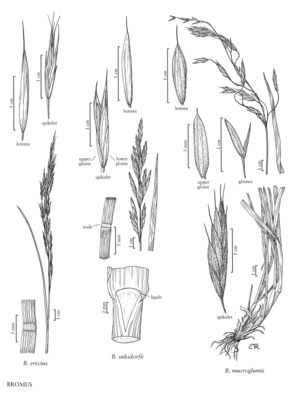Bromus suksdorfii
Plants perennial; not rhizomatous. Culms 50-100 cm, erect; nodes 2-3 (4), glabrous, internodes glabrous or puberulent just below the nodes. Sheaths glabrous; auricles absent; ligules to 1 mm, glabrous, truncate; blades (8) 12-19 (24) cm long, 4-8 (14) mm wide, flat, glabrous, margins scabrous. Panicles 6-14 cm, erect, contracted; branches erect or ascending. Spikelets 15-30 mm, elliptic to lanceolate, terete to moderately laterally compressed, with (3) 5-7 florets. Glumes glabrous or sparsely pubescent; lower glumes 7-11 mm, 1 (3) -veined; upper glumes 9-12 mm, 3-veined; lemmas 12-15 mm, elliptic, rounded over the midvein, backs and margins pubescent or nearly glabrous, apices obtuse, entire; awns 2-5 mm, straight, arising less than 1.5 mm below the lemma apices; anthers 2-3.5 mm. 2n = 14.
Distribution
Calif., Wash., Idaho, Nev., Oreg.
Discussion
Bromus suksdorfii grows on open slopes and in open subalpine forests, at about 1300-3300 m, from southern Washington to southern California.
Selected References
None.
Lower Taxa
"decumbent" is not a number.
